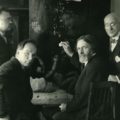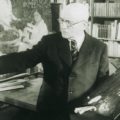In 2021, the All-Russian Artistic Scientific Restoration Center celebrates the 150th anniversary of the birth of its founder Igor Grabar. Many people know him as a painter, a representative of Russian impressionism, a member of the leading artistic associations of the time, “World of Art” and “Union of Russian Artists”. But the work of Igor Grabar was not limited only to painting.
The contemporaries of Igor Grabar were amazed at his ability to work and his incredible level of activity: he managed to simultaneously work as an art critic, artist, scientist, and publicist. It was in his student years, when, according to his memoirs, “life flowed along three different courses — scientific, literary and artistic.”
The future artist began to show interest in history and art in childhood. Grabar recalled: “I always received [for Christmas] some kind of drawing supplies […] When the passion for drawing began, I don’t remember, but suffice to say that I don’t recall myself not drawing, I cannot imagine myself without a pencil, an eraser, without watercolors and brushes “.
While studying at the Yegoryevskaya progymnasium, and after at the Moscow Lyceum of Tsarevich Nicholas, Grabar did not abandon his hobby. During these years, Igor was fortunate enough to meet the Shchukin family of collectors, who were part of the circle of eminent figures of culture and art. The younger Shchukin, Ivan, a close friend of Grabar, knew not only all Russian artists but also French, German, English, and Spanish ones and passed on details about them to Igor who was ready to listen all day long. Grabar spent his free time at the Tretyakov Gallery or visiting artists, gaining experience of critical judgments about the works of both national and foreign masters.
In 1889, he entered the law faculty of St. Petersburg University and rather quickly became a popular author and illustrator of satirical and historical magazines, not abandoning his dream of becoming a professional artist. In 1894, Igor Grabar succeeded with his plan: after participating in several stages of enrollment competition, he was admitted to the workshops of Pavel Chistyakov and Ilya Repin in the Imperial Academy of Arts. In parallel with his studies, young Grabar had the opportunity to have his first experience in the field of art criticism. The magazine “Niva” periodically published his articles about St. Petersburg exhibitions, in which Grabar analyzed not only contemporary works of art, but also talked about the problems of theory and the importance of Russian culture in the world.
In 1910, the publishing house of Joseph Knebel published the first volume of Igor Grabar’s fundamental work “The History of Russian Art”. By 1916, he and a team of experienced specialists published other books of the series, which brought the author not only all-Russian but also European fame. Igor Grabar managed to collect unique material from various archival and museum sources, which presented the architectural and artistic masterpieces of Russian art in close relationship with the history of the country.
There are many scientific works and publications in which Igor Grabar is presented as an art historian, artist, and public figure. But for the staff of the Grabar Art Conservation Center, his work on the creation of a national school for the restoration of historical and cultural monuments has particular importance. In 1917, during the radical changes in public and private life, an extensive collection of Russian art and numerous architectural monuments needed protection and restoration. The need to organize a centralized restoration institution became obvious for the leaders of the People’s Commissariat for Education. Anatoly Lunacharsky, its head, in 1918 invited Igor Grabar to head the State Collegium for Museums, Protection of Art and Antiquities. The Collegium included a commission for the preservation and the restoration of outstanding examples of painting, and under the commission Central Restoration Workshops, which were in great need, were organized. The main work of these workshops was not only the discovery of old relics but also their comprehensive study.
Thanks to the work of Igor Grabar in these years, the foundation for a system of accounting, storage, study, and restoration of art objects was established. The system was based on clear theoretical and methodological principles of scientific restoration and museum storage. It included innovations in the design of cards describing the preservation of the exhibits, restoration protocols, and photographs of each stage of restoration. In printed materials, Grabar wrote detailed instructions on the packing and transportation of art objects, attached samples of inventory cards, and even specifically described methods for placing the exhibits in storage. All this knowledge became the basis for the museum storage system and restoration work, which gradually transformed into the modern museum system.
It is important to note that Igor Grabar not only introduced the concept of scientific restoration but also laid out the foundation for a whole movement in restoration practice: together with the first specialists of the Central Restoration Workshops and like-minded scientists, he made more than 10 scientific expeditions to Russian cities. Among the first colleagues of Igor Grabar were the leading icon painters and restorers of the pre-revolutionary period Grigory Chirikov, Vasily Kirikov, I. Suslov, Pyotr Baranovsky, Nikolai Pomerantsev, as well as the specialists of the study of ancient Russian art Alexander Anisimov and Vasily Georgievsky. The purpose of these expeditions was the preservation and restoration of monuments as well as the discovery of new ones.
In 1919, Igor Grabar wrote: “We need to study the cultural heritage of our country and protect and collect it in every possible way. […] The good that the past gave us, we must save.” The staff of the Center do not forget these words and continue the great work of saving items of art.
Alexandra Kuntina,
The Grabar Art Conservation Center


